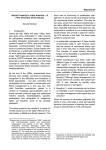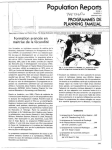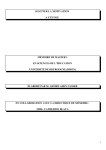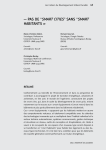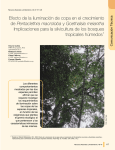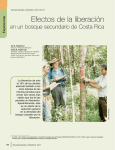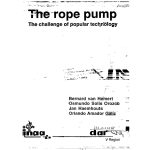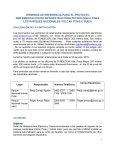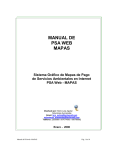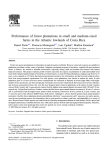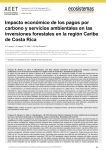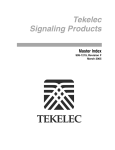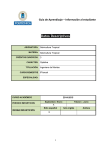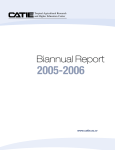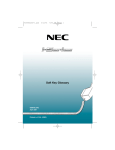Download 12 Costa Rica
Transcript
12 Costa Rica B. Louman 12.1 Introduction Costa Rica is a relatively small country in Central America of about 5.1 million hectares in surface area and 4 million inhabitants, but with a great natural diversity distributed over twelve of Holdridge’s ecological life zones (Hartshorn 1983). It has been able to convert its deforestation from 46,500 - 49,000 ha.y-1 in the 1960s and 70s to a slight net forest cover gain since 1987 (Wendland & Bawa 1996; Camino et al. 2000; FAO 2002). The actual forest area covers 2.4 million hectares (FAO 2007). Although a great part of the changes in forest area – and therefore deforestation rate estimates – may be due to changes in forest definition, differences in methodologies as well as in improved technology (Camino et al. 2000; FAO 2002; Houghton 2003), it also reflects changes in agricultural and forest policies and strategies, as well as the ability of the government and private sector to establish plantations, allow secondary forests to regenerate and implement sustainable forest management (SFM) activities that involve, and go beyond, the sustainable harvest of timber. SFM in natural forests has been relatively successful in Costa Rica, contributing to up to 80 % of the nation’s timber supply in 1999 (FAO 2002). Since then – with first commercial tree plantations entering into their final harvests in 1997 – its contribution has rapidly dwindled to about 5 % in the years from 2005 to 2009, with trees outside forests and plantations providing initially an increasing proportion of the national supply (Barrantes & Salazar 2006), but later declining due to a declining demand for timber products (ONF 2010). Some experts presume, however, that within the current structure of the domestic demand, plantation timber will not be able to substitute the high quality timber from natural forests (McKenzie 2003). On the other hand, in recent years the high demand for agricultural crops, such as pineapple and banana, is influencing the demand for timber for pallets, using plantations as their main raw material source (Barrantes & Salazar 2006). 213 Sustainable Management of Tropical Rainforests - the CELOS Management System As early as 1997 sawmills saw their traditional raw material supply of large sized logs reduce considerably, forcing them to close or change towards the processing of smaller logs from plantations and secondary forests (Camino et al. 2000). Starting in 2007, Costa Rica has become increasingly dependent on timber imports, first from Nicaragua, but later above all from Chile and Argentina (ONF 2010) to provide its domestic demand for timber products, and stakeholders are discussing whether and how to bring more natural and planted forest area under SFM for timber production. 12.2 Forest reserves and off-reserve tree resources and their utilization Costa Rica administers its forests through eleven Conservation Areas. In 1999 they administered 1,3 million hectares (approximately 56 % of the total natural forest area) in six management categories, 56 % of which was state owned and 44 % private (FAO 2002). The same source reported that state administered forests reserved for future timber production occupied an area of 286,660 ha. Although legally declared reserves, 74 % of these are still privately owned. Another one million hectares1 of forest area exists outside these different categories of protection. Most of these forests are secondary forests of different development phases (around 700,000 ha, Camino et al. 2000; FONAFIFO & ONF 2006) and plantations (around 45,000 - 54,000 ha, FONAFIFO & ONF 2006) and may contribute to the future potential for timber production from natural forests in Costa Rica. All of the forest area outside the protected areas is privately owned, usually in properties of less than 300 ha. About 212,000 ha of these had received Payment for Environmental Services (PES) between 1997 and 2008, of which 86 % was assigned to privately protected areas (MINAET 2010, see also Box 1). Table 12.1. Types of forest lands with mayor uses in Costa Rica. Type of forest land Mayor uses 1. Natural forests a. SINAC administered (National Conservation Area System) Environmental services, some non-timber forest products in forest reserves (such as mosses, berries) b. Privately protected Environmental services, in particular tourism, carbon storage, maintenance of biodiversity and protection of water sheds c. Private multiple use Timber (construction, furniture), non-timber forest products, environmental services 2. Plantations Timber (mainly pallets for agro-export, but also construction and furniture), carbon sequestration 3. Trees outside forests Timber, shade, fruits, carbon sequestration Planted forests have assumed an important role in the timber supply. Camino et al. (2000) estimated the plantation area at 140,000 ha in 1997 and FAO estimated that it reached 178,000 ha in 2000, all privately owned but of which 154,000 ha were established with some type of state support and the rest through private initiatives by forest companies (FAO 2002). These data may not reflect the extent of plantations of commercial use, which 1 214 FONAFIFO 2007 reported 1.3 million ha and assigned 1.1 million ha to the different management categories. 12. Costa Rica FONAFIFO estimated to be 45,000 ha by the end of 2005 (FONAFIFO & ONF 2006). The newly planted area has decreased from approximately 9,000 ha in the early nineties to less than 3,000 ha annually since the year 2000, raising the expectations of a raw material deficit during the coming years (FONAFIFO & ONF 2006). There are five types of mayor forested areas in Costa Rica (Table 12.1). Of these types, trees outside forests receive increased attention (Van Leeuwen & Hofstede 1995; FAO 2002) and since 2002 the PES system has paid for nearly 2 million trees to be planted in different types of agroforestry systems (FONAFIFO 2008, see also Box 12.1). Box 12.1. Payment for environmental services (PES) in Costa Rica. In its 1996 forest law Costa Rica recognized four types of environmental services: carbon storage and sequestration; maintenance of biodiversity; regulation of a clean water supply; and scenic beauty. A year later, a payment for environmental services scheme was set up that coordinates, on the one hand, the payments received from bi- and multilateral agreements (e.g. Norway, World Bank loan, Global Environmental Facility), from carbon polluters (through a type of carbon tax on the gasoline), water users (hydroelectric power generators and beverage companies) and through sale of certificates. On the other hand, it distributes the funds to the providers of environmental services. This distribution is based on the assumption that existing natural forests provide the said services simultaneously at approximately the same proportion (25 % of total value paid). Plantations are expected to provide more of some of the services (carbon sequestration) and increase the services rendered in relation to the previous land use (mostly degraded pastures). Forest management reduces the total services rendered in comparison to protected forests, but is assumed to maintain the same proportionality between services. This form of Payment for Environmental Services was suspended in 2002 under pressure of environmental groups that argued that forest management already generates an income and that the state should not increase this income through PES. This was replaced by payments for the planting of trees in agricultural systems, since the decision makers considered that this would be more effective, providing services through carbon sequestration and maintenance of biodiversity. The latter above all through providing connectivity between forest fragments. The amounts paid to the providers are determined annually and are based on the opportunity costs of adopting the required good practices, rather than on the quality and quantity of services rendered. In the case of natural forest protection, marginal cattle farming is used as a reference (in 2008 this was about US$ 64 ha-1.y-1 paid during renewable five year contract periods). In the case of plantations, the costs of establishing plantations is used as a guideline, actually paying US$ 816 ha-1 spread over 5 years, which covers approximately 75 % of total costs. It is assumed that all services are rendered as long as forest, plantation or trees exist and good practices, as indicated in the service contracts, are applied. This simplifies the payments and allows monitoring to concentrate on practices and forest cover, rather than on the costly measuring of services rendered. It does, however, not recognize the different levels of threat that the forests in different areas of the country experience. 12.3 Historical development in forest exploitation During the 1950s and 1960s, Costa Rica went through a period of colonization of its lowland forest areas, promoting conversion of forests into pasture lands through, among other measures, recognition of land titles on “improved” land (FAO 2002; Hilge et al. 215 Sustainable Management of Tropical Rainforests - the CELOS Management System 2002). Harvesting of trees in the natural forests was very selective, limited to a few species of high value for the market (e.g. Cedrela odorata, Swietenia macrophylla), or for local construction and agricultural production purposes (e.g. poles of Minquartia guianensis were cut for the pepper and vanilla cultivation; Camacho & Finegan 1997; FAO 2002; Méndez 2008). Costa Rica had its first forest legislation in 1969, and since 1973 (foundation of the National University, UNA) and 1976 (foundation of the Costa Rican Institute of Technology (ITCR)) national universities offer forestry curricula. It was, however, not until 1984 that the first management plan was elaborated based on an explorative forest inventory. In the new forest legislation of 1986 management plans were incorporated and during the same year it was prohibited by decree to convert forest land use into other types of land use that involved removing the forest cover (MINAE 2002). In 1992 harvest regulations were issued and Certificates for Forest Management (CAFMA) were granted as a form of subsidies for sustainable forest management (Maginnis et al. 1998; FAO 2002). All of these combined induced a rapid evolution of polycyclic management of natural forests, drawing from experiences in other Latin American countries (in particular the CELOS Management System in Suriname) as well as from South-East Asia (e.g. Finegan et al. 1993; Méndez 1993; CATIE 1994; Quirós & Finegan 1994; Wendland & Bawa 1996; Méndez 2008). In 1996, the Portíco operations in natural Carapa forests in the North of Costa Rica became the first FSC-certified forest operations of the country, a certification which it has maintained ever since. NGOs, such as JUNAFORCA, CODEFORSA and FUNDECOR, assumed a leading role as forest management advisors for large groups of small holders, working with owners of both natural forests and plantations. From 1994 until 1998 different actors, driven by the private sector and supported by the government, studied the impacts of timber harvesting in the country. They formed a working group to prepare a proposal for a standard for sustainable forest management for Costa Rica using the impact studies as basis for the development of indicators. This standard was incorporated into the 1996 forest legislation, and its criteria and indicators were formally approved as legal norms in 1998 (CNCF 1999). This standard was revised in 2002 and a new revision was done in 2007 resulting in a new, less prescriptive standard, gazetted in 2008 (MINAE 2008). In the early nineties, interest increased in forest goods and services other than timber and the 1996 forest law recognizes for the first time the value of forests for the provision of four types of services: water regulation, maintenance of biodiversity, carbon sequestration and storage, and scenic beauty. A system was set up to channel money from users to the producers (Payment for Environmental Services or PES, see Box 12.1) and the first payments were made in 1997. Originally, this scheme also included PES for forest management that complied at least with legal norms for harvesting and postharvesting treatment of the forests. In order to ensure the production of environmental services in the forest, the new legislation put restrictions on timber harvests: increasing the costs of planning, reducing the annual allowable cut, requiring more water and soil protection measures within management units, and requiring the implementation of silvicultural treatments. To compensate for these extra costs, it was decided to also implement payment for the maintenance of environmental services through sustainable 216 12. Costa Rica forest management (Campos et al. 2001). In spite of the positive effect of PES on the quality of forest management (Louman et al. 2005), this modality was suspended in 2002 in favour of payment for tree planting within agroforestry systems (FONAFIFO 2008), thought to be a more effective way to produce the desired services (mainly carbon sequestration and maintenance of biodiversity). Interestingly, between 1992 and 1996 the supply of timber from natural forests and plantations reduced considerably, while after the implementation of the 1996 legislation it went back to 1992 levels and beyond (McKenzie 2003) until the new forest management standard started to be implemented in 1999 and PES for forest management was suspended in 2002. After that, management of natural forests has decreased again (Barrantes & Salazar 2005). The strict regulations, the long administrative processes to obtain harvesting permits (FAO 2002; Méndez 2008), and the lack of compensation for measures that maintain environmental services have probably contributed to this decline. But also the reduction in harvestable forest areas due to overcutting in the eighties and early nineties (McKenzie 2003), the slow adaptation of the processing industry to changing market and supply conditions (FAO 2002), the strong competition from cheaper wood from plantations in and outside the country and substitution of wood by other cheaper or more durable (but not necessarily more sustainable) materials in house construction have played a role. 12.4 Silvicultural systems, productivity, annual allowable cut In Costa Rican natural forests, according to the 1996 forest law, silvicultural systems have to be polycyclic. Until 2008 the main criteria for these systems was a minimum length of the cutting cycle of 15 years and application of minimum cutting diameter limits (60 cm for all species) as well as a maximum cutting intensity (60 % of harvestable trees of a species; Maginnis et al. 1998). These criteria have been converted into technically justifiable criteria according to each forest type and forest operation (MINAE 2008). Data on forest recovery during the first (official) complete management cycle starts to become available, indicating that if harvesting and management is implemented according to the national standards the forest recover the harvested volumes (Méndez 2008) while no apparent structural or compositional changes occur (Delgado et al. 1997; Alfaro 2006). In practice this means an average harvest of between 10 and 20 m3.ha-1 per harvest or on average 0.67-1 m3.ha-1.y-1 (Camacho & Finegan 1997; SINAC 1999; Alfaro 2006; FONAFIFO & ONF 2006). Photo 12.1. Detailed planning of timber harvest is the most important silvicultural activity in Costa Rican natural forests. All FONAFIFO & ONF (2006) estimated the forests commercial trees and terrain characteristics are measured and available for timber production to be 533,000 mapped, as are the trees that for specific silvicultural reasons ha. They estimate that using the currently should not be cut. (Photo FUNDECOR 2001) 217 Sustainable Management of Tropical Rainforests - the CELOS Management System common cutting cycle of 15 years, this would allow annually about 35,000 ha to be harvested, in contrast to the 2005 figure of about 3,000 ha annually (derived from the same publication). With an average harvest of 15 m3.ha-1 the harvest of 35,000 ha.y-1 represents 525,000 m3.y-1, ten times the current level of harvesting and approximately 33 % of the expected demand for timber in 2020 (FONAFIFO & ONF 2006). The rest will have to come from plantations or be imported. 12.5 Current practice Forest management in Costa Rica occurs mainly in smallholder plots with an average size of approximately 70 ha (Maginnis et al. 1998). Management planning is usually done by a registered forest regent, holder of a forestry degree, and legally responsible for the veracity of planning documents and supervisory reports. The forest regent shares this responsibility with the land owner and together they have to supervise the implementation of harvesting, usually done by contractors. Planning and implementation need to follow strict rules, set out in the standard for natural forest management. This standard has recently been modified (MINAE 2008), but up to date only few operators have obtained experience under the new rules. Due to the small size of the operations, management and harvest planning are usually done simultaneously for the whole forest area. As a first step a team enters to set up a network of inventory lines and take topographic measures that allow drawing a detailed topographic map of the area at a scale of approximately 1:1000 to 1:4000. This is followed by a commercial inventory of all trees Photo 12.2. Potential seed trees are clearly marked in the field more than 60 cm diameter at breast height to prevent felling damage. Here: Carapa guianensis. (Photo CATIE (dbh) of all commercial species (up to 40 in archives 2010) each forest plot) and an inventory of all trees greater than 30 cm dbh of all species, in sample plots of 30 x 100 m, covering usually about 4.5 % of the productive area2 (Photos 12.1 & 12.2). Tree location is estimated using GPS or the dense inventory line network as reference. Most organizations, such as FUNDECOR, have developed their own computerized methods to do so, allowing them 2 The new forest management standard (MINAE 2008) no longer applies a minimum cutting diameter (MCD) of 60 cm but allows operators to justify MCDs for different species in different forest types. The implementation of the commercial inventory needs to be adjusted accordingly. 218 12. Costa Rica to draw accurate maps with contour lines at 2 to 5 m intervals, location of protection zones due to nearness of water courses or steep slopes3, delineation of productive forest area, location of commercial trees and their natural felling direction, and the location of the road network needed to extract the trees (FAO 2001). Planning is followed by reduced impact logging operations, applying directional felling and, in about 40 % of the cases (Obando 1997), 30 m cables to extract the timber. Usually small bulldozers are used both for road work and timber extraction. Log landings are placed outside the forest area wherever possible. Post harvest activities used to be based on silvicultural plans, following diagnostic sampling adapted for mixed-age forests from Asian line sampling (Hutchinson 1993). This sampling was designed to indicate whether liberation treatment would be necessary or not, tallying the number of outstanding future crop trees and evaluating their social position in the forest. Due to the abundance of commercial trees in the forests and the possible need for additional treatments, adaptations were made to the sampling design, eliminating the tallying of trees with a dbh below 10 cm and adding the tallying of all trees within the 10 × 10 m plots to get an idea of basal area Photo 12.3. A forest several years after timber harvest and light competition (Quirós 1998). In the first years of liberation treatments. (Photo Marie Landry 2007) its application this sampling produced very useful results, but organizations that only worked in one type of forests, using more or less a constant harvesting intensity and similar extraction methods, found that the results of the sampling became repetitive and did no longer justify the costs (about US$ 9 ha-1, Quirós & Gómez 1998). The new forest management standard does no longer require diagnostic sampling, unless the impacts of proposed harvesting cannot be predicted from previous studies (Photo 12.3). Liberation of future crop trees is the main silvicultural treatment that has been applied in the Costa Rican tropical lowland forests. Considering the effects of removal and death of trees through harvesting and silvicultural treatments together, legislation allows for a maximum reduction of 40 % in the basal area of trees above 30 cm dbh. While in research plots initial results have been very promising, achieving growth rate increments of up to 50 % (e.g. Camacho & Finegan 1997), later research indicated that more studies need to be done on the response of individual species in different size classes. This should allow for the liberation of those crop trees that have a good response potential (e.g. Galván et al. 2006) and may avoid increased mortality (e.g. Alfaro 2006). Since 2002, after suspension of PES for forest management, few operations apply silvicultural treatments 3 The legal limit was 60 % but FUNDECOR applied 35 % for use of machinery and 75 % for cutting and cable extraction. The new standards (MINAE 2008) no longer prescribe maximum slopes above which harvesting is not allowed, but require impact reduction measures adequate to the local circumstances. 219 Sustainable Management of Tropical Rainforests - the CELOS Management System or prepare silviculture plans and the norms only require doing so if necessary for the maintenance of the structure and floristic composition of the forest. Different organizations have established more than 500 permanent sample plots (PSP) in the Costa Rican forests (Finegan, pers. comm.4), some of which have greatly contributed to the current knowledge on the natural forests, their management and its impacts. Until recently, however, this information was scattered and little accessible for researchers and forest managers. Considering the increased importance of monitoring of changes in the forests due to management and climate change, these organizations have formed a research network that should allow the forest sector to adapt to changing circumstances and improve the information needed to adequate decision-making. 12.6 Main issues restricting sustainable forest management at present Current legal natural forest management practices can be considered good (Louman et al. 2005; Barrantes & Salazar 2006) but only supply 5 % of the local timber demand, the rest coming from plantations, trees outside the forest and imports. Major threats to natural forest management are illegal logging and forest conversion (e.g. Barrantes & Salazar 2006; Campos et al. 2007) and fires (SINAC 2006). With an increasing demand and the inability of plantations to provide the necessary raw materials (McKenzie 2003; Barrantes & Salazar 2006) the pressure on the natural forests will increase as will the threat of illegal logging (FONAFIFO & ONF 2006). Managed natural forest will remain an important source of timber in the near future (McKenzie 2003; Barrantes & Salazar 2006; FONAFIFO & ONF 2006) but will only be able to do so if a sustainable manner of its management is promoted. This requires the forest sector to address a number of limitations (extracted from McKenzie 2003; FAO 2004; FONAFIFO & ONF 2006; Campos et al. 20007; Méndez 2008): • Improve control mechanisms; financial and human resources are insufficient to implement detailed control on forest and timber transport operations. Current mechanisms still facilitate corruption while legal offenses are mildly punished. Although improvements in these aspects are very necessary, these may have little effect if these are not accompanied by improvements in any of the other factors mentioned below. • Increase participation of society in promotion of sustainable forest management; environmentalists lobbying has achieved very strict legislation for forest management, making it easier to convert forests (illegally) into agricultural land than to apply forest management. Society is conservation-oriented and PES for protection has been able to increase the protected forest areas by about 40 %. However, non-protected areas continue to be converted or are heavily degraded by uncontrolled logging and agricultural activities. SFM could have an important role in conserving the forest cover in these areas, as well as in the increasing area 4 Bryan Finegan, October 2008. Director of the chair of forest ecology of CATIE. He participates in the newly established research network. 220 12. Costa Rica • • • • • under secondary forests. This will not be possible if society maintains a poor, sometimes erroneous image of SFM. Improve administrative procedures for approval of harvesting; waiting for six months or more for harvest plan approval has made many forest owners opt for other forms of land use, including protection but also gradual conversion into agricultural lands. Reduce excessive legislation related to forest management; related to the previous point, costs of forest management are elevated by excessive legislation, in particular related to the standards for forest management. These have recently been modified and greater transparency and flexibility has been created. It is still too early to assess the effects of these changes. No effect could be seen during 2009, but this may have been due to the global financial crisis (ONF 2010), rather than to lack of effectiveness of the changes in the standard. Without additional options for financing forest activities, however, the realized changes may not achieve the desired effects. Additional financial resources for forest management (such as PES, cheap credits, private investment); only few forest operators have invested in plantations and improved forest management, considering the road between investment and profit making too long and risky. Experiences in the private sector have shown that reducing the fixed costs through economies of scale, increasing the price of timber for the producers through market association, and making money available before harvesting Photo 12.4. After recognition of ecosystem services in the through forward payment schemes, all 1996 forest law and partially due to the complicated procedures contribute to the motivation of forest to obtain forest management permits, many forest owners owners to invest. So did the PES system. preferred forest management for protection rather than for While the latter was suspended for timber production, and receive an income from payment for forest management in 2002, the other environmental services, rather than from timber sales. options are not widely available but (Photo Colegio de Ingenieros Agrónomos de Costa Rica 2008). could be promising. Several forest owners are venturing into the carbon market, while companies outside the forest sector, in response to calls for greater social responsibility, have started to invest into the maintenance and enhancement of carbon stocks in private (degraded) forests. These funds are creating a demand for management of the carbon stock in the forests, requiring adjustments in the existing SFM guidelines. Improve competitiveness of the industry at all shackles of the value chain; particularly primary industry is little developed in Costa Rica. The current characteristics of the raw material supply (smaller diameters, lower quality timber) requires for investments in new machinery and development of new products. 221 Sustainable Management of Tropical Rainforests - the CELOS Management System • Improve the information base as well as the monitoring and research capacity; forests are complex and still little is known of the long-term reaction of specific species to forest management and climate change. Although legislation has improved enormously over the past decade, still policy decisions are made without knowing the consequences or those of previous policy decisions. Monitoring frameworks and research could contribute to better decision-making in the future. However, in spite of the 2000 national forest inventory that, with the assistance of FAO, developed a good methodology to collect information on multiple resources in and outside a network of permanent sample plots, no inventory or monitoring framework exists in Costa Rica. SFM practices were originally derived from the CELOS experiences, in particular regarding the harvesting system. Over time, Costa Rica has gone well beyond the CELOS system in the application of exact planning tools and adjusting silvicultural treatments to national objectives with greater emphasis on the conservation of biodiversity. Lessons learned from these experiences have allowed the forest sector to revise the legal framework and come up with a proposal of forest management standards more appropriate for the current situation. This development, however, led to the development of a highly technified and regulated SFM, even to such an extent that the resulting high planning and administrative costs, combined with the reduced harvesting levels, did not make SFM an attractive land use proposition for many private forest owners, in particular where PES could be received for forest protection without much investment (Photo 12.4). Innovative financing mechanisms and the political will to set up adequate legal, administrative and monitoring systems will be necessary if SFM is to fulfil its potential contribution to Costa Rican’s economic development without further degrading the forests’ capacity to provide ecosystem services. References Alfaro, T. 2006. Estudio de condiciones para segundas cosechas en bosques naturales en la zona Norte de Costa Rica. Tesis Mag. Sc. CATIE, Turrialba, Costa Rica. 134 pp. Barrantes, A. & Salazar, G. 2006. Uso y aportes de la madera en Costa Rica. Estadísticas 2005. Oficina Nacional Forestal (ONF), San José, Costa Rica. 28 pp. Camacho, M. & Finegan, B. 1997. Efectos del aprovechamiento forestal y del tratamiento silvicultural en un bosque húmedo del noreste de Costa rica; el crecimiento diamétrico con énfasis en el rodal comercial. CATIE, Turrialba, Costa Rica. Serie técnica, informe técnico no. 295. Colección Manejo Diversificado de Bosques Naturales no. 11. 38 pp. Camino, R. de, Segura, O., Arias, L.G. & Pérez, I. 2000. Costa Rica. Forest strategy and the evolution of land use. Evaluation country case study series. World Bank, Washington DC, USA. 128 pp. Campos, J.J., Finegan, B. & Villalobos, R. 2001. Management of goods and services from neotropical forest diversity: diversified forest management in Mesoamerica. In: CBD technical note 3, 5-16. 222 12. Costa Rica CATIE (Centro Agronómico Tropical de Investigación y Enseñanza). 1994. Modelo de simplificación de planes de manejo para bosques naturales de la región centroamericana. CATIE, Turrialba, Costa Rica. 29 pp. CNCF (Comisión Nacional de Certificación Forestal) 1999. Estándares y procedimientos para el manejo forestal sostenible y la certificación forestal en Costa Rica. CNCF, San José, Costa Rica. 51 pp. Delgado, D., Finegan, B., Zamora, N. & Meir, P. 1997. Efectos del aprovechamiento forestal y el tratamiento silvicultural en un bosque húmedo del noreste de Costa Rica. Cambios en la riqueza y composición de la vegetación. CATIE, Turrialba, Costa Rica. Serie técnica, informe técnico no. 298. Colección Manejo Diversificado de Bosques Naturales no. 12. 43 pp. FAO (Food and Agricultural Organization ) 2001. El uso de computadoras, porgramas e instrumentos electrónicos en la planificación y seguimiento de planes de manejo del bosque húmedo tropical – un caso en Costa Rica. Manejo forestal – documento de trabajo no 1. FAO, Roma, Italy. 75 pp. FAO. 2002. Estado de la Información Forestal de Costa Rica. Santiago, Chile. Proyecto GCP/133 RLA-FAO Información Forestal y Manejo Sostenible. FAO. 2004. Estado y Tendencias de la Ordenación Forestal en 17 Países de América Latina por Consultores Forestales Asociados de Honduras (FORESTA). Documentos de Trabajo sobre Ordenación Forestal; Documento de Trabajo FM/26; Servicio de Desarrollo de Recursos Forestales, Dirección de Recursos Forestales, FAO, Roma. Mayo 2004 (Inédito). Online: http://www.fao.org/docrep/008/j2628s/J2628S00. HTM FAO. 2007. The state of the world’s forests 2007. Rome, Italy. FAO & CATIE. 2000. FRA: Bibliografía comentada, cambios de la cobertura forestal, Costa Rica. Programa de evaluación de recursos forestales. Documento de trabajo 36. Roma, Italia. 55 pp. Finegan, B., Sabogal, C., Reiche, C. & Hutchinson, I. 1993. Los bosques húmedos tropicales de América central: su manejo sostenible es posible y rentable. Revista Forestal Centroamericana 6, 17-27. FONAFIFO (Fondo Nacional de Financiamiento Forestal). 2007. Estudio de monitoreo de cobertura forestal de Costa Rica 2005. Resumen ejecutivo. Consultant report Project ECOMERCADOS, FONDOS GEF – ECOMERCADOS CONVENIO DE DONACIÓN TF 023681. 7 p. online: http://documentacion.sirefor.go.cr/archivo/cobertura/ cobertura002.pdf. 22 Oct 2008. FONAFIFO. 2008. Distribución de las Hectáreas Contratadas en Pago de Servicios Ambiéntales, por Año y por Modalidad, Período 1997-2007. Corte al 20 de mayo 2008. Online: http://www.fonafifo.com/text_files/servicios_ambientales/distrib_ ha_Contratadas.pdf. Consulted 22 Oct 2008. FONAFIFO & Oficina Nacional Forestal (ONF) 2006. La Madera en Costa Rica. Situación actual y perspectivas. 23 p. online: http://www.oficinaforestalcr.org /media_files/ download/MADERAENCOSTARICA,SITUACIONACTUALYPERSPECTIVAS,2006.pdf. 23 Oct 2008. 223 Sustainable Management of Tropical Rainforests - the CELOS Management System Galván, O., Louman, B., Galloway, G. & Obando, G. 2006. Efecto de la iluminación de copa en el crecimiento de Pentaclethra macroloba y Goethalsia meiantha. Implicaciones para la silvicultura de los bosques tropicales húmedos. Naturales y Ambiente 4647, 117-126. Hartshorn, G.S. 1983. Chapter 7, Plants. Introduction. In: Janzen, D.H. (ed). 1983. Costa Rican Natural History. Chicago, USA, University of Chicago Press, 118-157. Hilge, L., Jiménez, W. &, Vargas, E. 2002. Los viejos y los árboles. Editorial de la Universidad de Costa Rica, Inbio, San José, Costa Rica. 423 pp. Houghton, R.A. 2003. Revised estimates of the annual net flux of carbon to the atmosphere from changes in land use and land management 1850- 2000. Tellus B, 55, 378-390 Hutchinson, I. 1993. Puntos de partida y muestreo diagnóstico para la silvicultura de bosques naturales del trópico húmedo. CATIE, Turrialba, Costa Rica. Serie técnica, informe técnico no. 204. Colección Silvicultura y Manejo de Bosques Naturales no. 7. 32 pp. Louman, B. & De Camino, R. 2004. Capítulo 1. Aspectos generales. In: L. Orozco Vïlchez (ed). Planificación del manejo diversificado de bosques latifoliados húmedos tropicales. CATIE, Turrialba, Costa Rica. Serie técnica, manual técnico no. 56, 1-54. Louman, B., Garay, M., Yalle, S., Campos, J.J., Locatelli, B., Villalobos, R., López, G. & Carrera, F. 2005. Efectos del pago por servicios ambientales y la certificación forestal en el desempeño ambiental y socioeconómico del manejo de bosques naturales en Costa Rica. Colección Manejo Diversificado de Bosques Naturales. Publicación no. 30. CATIE. Serie Técnica. Informe Técnico NO. 338. 31 pp. Magginis, S., Méndez, J. & Davies, J. 1998. Manual para el manejo de bloques pequeños de bosque húmedo tropical (con especial referencia a la zona norte de Costa Rica). Lara y segura asoc. San José, Costa Rica. 208 pp. McKenzie, T.A. 2003. Tendencias y para el Sector Forestal Nacional de Costa Rica Hasta el Año 2020. Consultant report for the Comisión Forestal de América Latina y el Caribe (COFLAC) Proyecto Tendencias y Perspectivas del Sector Forestal de América Latina. 23 p. available online: http://documentacion.sirefor.go.cr/archivo/ tendencias/ tendencias2020_2_.pdf. (22 Oct 2008). Méndez, J. 1993. Manejo del bosque natural en la Región Huetar Norte de Costa Rica. Revista Forestal Centroamericana 6, 42-49. Méndez, J. 2008. El manejo silvicultural policíclico en bosques húmedos de bajura en la Región Norte de Costa Rica. Oral presentation VI Latin American Forestry Congress, Venezuela, 2-5 April 2008. 16 p + figures and tables. MINAE (Ministry of the environment and energy). 2002. El éxito forestal de Costa Rica en cinco casos. San José, Costa Rica, 60 pp. MINAE (Ministry of the environment and energy). 2008. Estándares de sostenibilidad para manejo de bosques naturales: principios, criterios e indicadores, código de prácticas y manual de procedimientos. La Gaceta 115, 24-27. MINAET (Ministry of the environment, energy and telecommunication) 2010. Readiness Preparation Plan Costa Rica. San José, Costa Rica. 224 12. Costa Rica Obando, G. 1997. Evaluación del desempeño de vías de transporte menor asistido por computadora para el aprovechamiento selectivo de guácimo (Goethalsia meiantha) en un bosque húmedo tropical de tierras bajas ubicado en Sarapiquí, Costa Rica. Tesis, Mag. Sc. CATIE, Turrialba, Costa Rica. 105 pp. Oficina Nacional Forestal (ONF) 2010. Costa Rica Forestal. Usos y aportes de la madera en Costa Rica, estadísticas 2009. ONF, Belén, Heredia, Costa Rica. 23 pp. disponible en www.onfcr.org. Accessed 23 March 2011. Quirós, D. 1998. Muestreos para la prescripción de tratamientos silviculturales en bosques naturales latifoliados; guía de campo. CATIE, Turrialba, Costa Rica. Manejo forestal tropical no 4. 8 pp. Quirós, D. & Gómez, M. 1998. Manejo sustentable de un bosque primario intervenido en la zona Atlántica norte de Costa Rica: Análisis financiero. CATIE, Turrialba, Costa Rica. Serie técnica, informe técnico no. 303. Colección Manejo Diversificado de Bosques Naturales no. 13. 22 pp. Quirós, D. &, Finegan, B. 1994. Manejo sostentable de un bosque natural tropical en Costa Rica. CATIE, Turrialba, Costa Rica. Serie técnica, informe técnico no. 225. Colección Silvicultura y Manejo de Bosques Naturales no. 9. 25 pp. Sader, S. & Joyce, A. 1988. Deforestation Rates and Trends in Costa Rica, 1940 to 1983. Biotropica 20, 11-19. SINAC (Sistema Nacional de Areas de Conservación). 1999. Breve descripción del estado de los recursos forestales en Costa Rica. San José, Costa Rica. 21 pp. SINAC. 2006. Estrategia nacional de manejo del fuego de Costa Rica 2006-2010. Online: http://documentacion.sirefor.go.cr/ archivo/incendios/emf_2006.pdf. 22 Oct 2008. Van Leeuwen, A.C.J. & Hofstede, A.M. 1995. Forests, trees and farming in the Atlantic zone of Costa Rica. CATIE, Guápiles, Costa Rica. Serie técnica Informe técnico no 257. 48 pp. Wendland, A. & Bawa, K.S. 1996. Tropical forestry: The Costa Rican experience in management of forest resources. Journal of sustainable forestry 3, 91-156. 225













